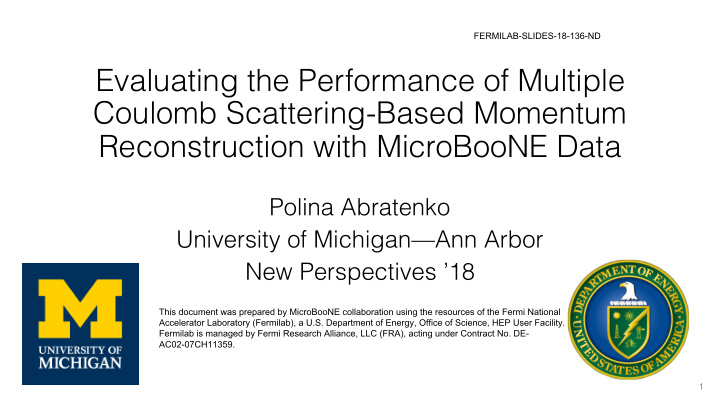



FERMILAB-SLIDES-18-136-ND Evaluating the Performance of Multiple Coulomb Scattering-Based Momentum Reconstruction with MicroBooNE Data Polina Abratenko University of Michigan—Ann Arbor New Perspectives ’18 This document was prepared by MicroBooNE collaboration using the resources of the Fermi National Accelerator Laboratory (Fermilab), a U.S. Department of Energy, Office of Science, HEP User Facility. Fermilab is managed by Fermi Research Alliance, LLC (FRA), acting under Contract No. DE- AC02-07CH11359. 1
The MicroBooNE Experiment • Goals: investigate the excess of low energy events seen by LSND/MiniBooNE (maybe due to oscillations), study neutrino- argon cross-sections, LArTPC R&D… • Neutrino oscillation for the two neutrino case: P α → β = sin 2 (2 θ )sin 2 ( ∆ m 2 L ) 4 E P = probability of a neutrino of flavor α later being measured to have flavor β θ = mixing angle Δ m 2 = neutrino mass squared difference L = distance from neutrino source to detector E = energy of neutrino 2
The MicroBooNE Experiment • For ν μ CC events (used in cross-section/oscillation measurements), neutrino-induced muons are used to reconstruct neutrino energy • However, in MicroBooNE, ~50% of the time, these muon tracks are not fully contained in the TPC! • It’s not possible to use range or calorimetric methods to compute momentum; we must use Multiple Coulomb Scattering (MCS) 3
Multiple Coulomb Scattering • When a charged particle passes through some material, it undergoes EM collisions with atomic nuclei • After each collision, the particle's trajectory is deflected from its initial direction 4
Multiple Coulomb Scattering • The collection of these small deflections is distributed like a Gaussian, with a mean at 0 and RMS given by the tuned Highland formula: entum ! " = radiation length of argon p = particle momentum ! " ! β = ratio of particle velocity to c , z = magnitude of charge of particle l = distance travelled inside medium # $ , % = fit parameters # • We can determine the momentum of the particle if we know the angular deflections MCS is the only way to reconstruct the energy of exiting muon tracks in MicroBooNE! 5
Multiple Coulomb Scattering Algorithm Overview • We determine these angular deflections by splitting the particle’s track into segments and then computing the angle between adjacent segments • We use the Maximum Likelihood Method to calculate the momentum of a given muon • Input angular deflections • Raster likelihood scan from 1 MeV to 7.5 GeV • Momentum and RMS updated through use of energy-range relation • Conditions: • Nominal segment length of 14 cm • Tracks must be above 100 cm in length 6
MCS Performance on Contained Data Tracks 7
MCS Performance on Contained Data Tracks • Beam neutrino induced NumuCC data MicroBooNE collaboration, JINST 12 P10010 (2017) 8
MCS Performance on Contained Data Tracks • MCS bias vs. range momentum for both simulation and data MicroBooNE collaboration, JINST 12 P10010 (2017) 9
MCS Performance on Contained Data Tracks • MCS resolution vs. range for both simulation and data MicroBooNE collaboration, JINST 12 P10010 (2017) 10
MCS Performance on Exiting Data Tracks 11
MCS Performance on Exiting Data Tracks • MCS will ultimately be used to determine the momentum of exiting muons in data, so it's very important to quantify this! • But how would we measure this? • Doesn't make sense to compare to momentum from range! • Introduce "pseudo-exiting" tracks: • Take a fully contained track, cut it off somewhere along its length • We choose cutoff lengths of 2, 4, 6 segments exiting the fiducial volume (corresponding to 28 cm, 56 cm, 84 cm, respectively) • Note that we are limited in segment removal because we are dealing with contained tracks 12
MCS Performance on Exiting Data Tracks • First, we compared these pseudo-exiting tracks with real exiting tracks (all simulation) • To do this, we placed a cut on length outside the TPC for real exiting tracks MICROBOONE-NOTE-1049-PUB 13
MCS Performance on Exiting Data Tracks • Comparison of pseudo-exiting tracks for 2, 4, 6 segments removed • MCS bias and resolution versus range MICROBOONE-NOTE-1049-PUB 14
MCS Performance on Exiting Data Tracks • Comparison of pseudo-exiting tracks and data (2 segments removed) • MCS bias and resolution versus range MICROBOONE-NOTE-1049-PUB 15
MCS Performance on Exiting Data Tracks • Comparison of pseudo-exiting tracks and data resolution vs range • 4, 6 segments removed MICROBOONE-NOTE-1049-PUB 16
Conclusion •Performance of MCS for contained tracks was shown to be within 5-10% in MicroBooNE data •Comparable to the performance of MCS on contained simulated tracks •Performance of MCS for exiting tracks in data has been shown to be within 5% bias and under 20% resolution for 2 segments removed •Under 30% for 4, 6 segments removed •Comparable to results from simulation MicroBooNE is able to reconstruct the momentum of TPC-exiting muons using MCS at a resolution of under 20-30% 17
Backup 18
The MicroBooNE Experiment • Part of the Short Baseline Neutrino (SBN) program at Fermilab • Detector located 470 m from Booster Neutrino Beam (BNB) target • Liquid Argon Time Projection Chamber (LArTPC) technology • 90 tons active LAr in TPC (170 tons total in cryostat) • Current largest TPC in the U.S. actively taking data Dimensions: 2.3 m x 2.6 m x 10.4 m 19
• Example distribution of fractional inverse momentum difference with the fit used to compute the bias (mean) and resolution (width) of the MCS method 20
Varying Segment Length (a) Highland validation figure for 5 cm segment lengths. (b) Highland validation figure for 10 cm segment lengths. (c) Highland validation figure for 14 cm segment lengths. (d) Highland validation figure for 20 cm segment lengths. 21
Why do we place a cut on 100 cm? Contained Tracks: Standard Deviation vs. Reco Length 0.9 Fractional Momentum Resolution 0.8 0.7 0.6 0.5 0.4 0.3 0.2 0.1 0 0 50 100 150 200 250 300 350 400 Muon Reco Length (cm) 22
Recommend
More recommend